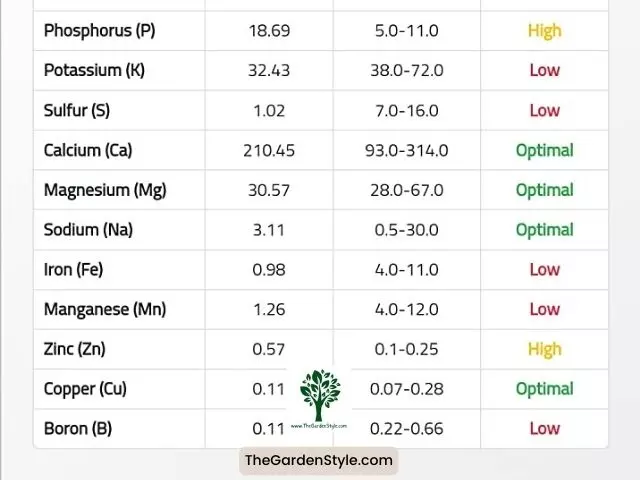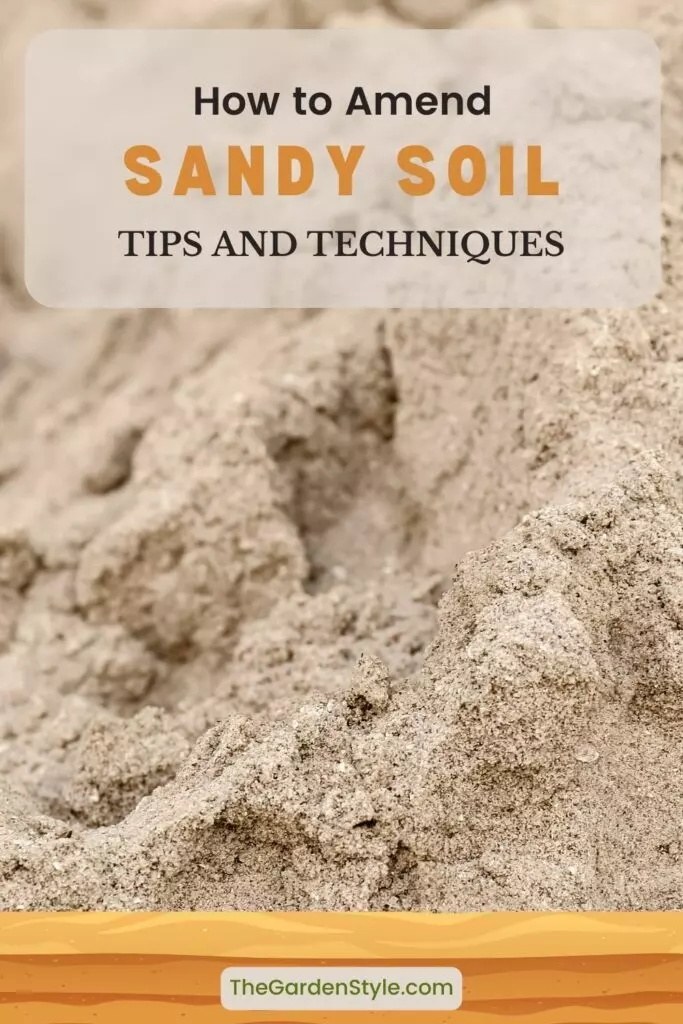Sandy soil can pose unique challenges for gardeners, but with the proper knowledge and amendments, you can transform it into a fertile and thriving environment for your plants. In this guide, we will explore what sandy soil is, why it needs amending, how to test it, effective methods for amendment, the ideal time for improvement, and common mistakes to avoid. Continue reading to learn more about how to amend sandy soil.
Table of Contents
What Is Sandy Soil?
It is crucial to understand the soil type in your garden as it directly affects the growth of your plants. Sandy soil is one of the most common soil types found in gardens. It is characterized by its gritty texture, which is a result of its high concentration of sand particles.
Sandy soil is known to be well-draining, which can be both a blessing and a curse. On one hand, it allows water to pass through quickly, preventing waterlogging and root rot. On the other hand, this can lead to a lack of moisture and nutrients, as they are unable to be retained in the soil.
It is essential to note that sandy soil can vary in its composition, depending on the location. For example, coastal sandy soil may have a higher salt content due to its proximity to the ocean. Therefore, it is crucial to conduct a soil test to determine the specific needs of your garden.

Why Amend Sandy Soil?
Amending sandy soil is a crucial step for gardeners seeking to optimize their growing conditions. While sandy soil offers the advantage of efficient drainage, it comes with significant drawbacks that can impede plant growth. Understanding the reasons to amend sandy soil is key to overcoming these challenges and creating a more fertile environment for your plants. Here’s why amending sandy soil is essential:
Low Nutrient-Holding Capacity: Sandy soil has a limited ability to retain essential nutrients, making it challenging for plants to access the nourishment they need for robust growth.
Rapid Moisture Drainage: The quick-draining nature of sandy soil results in rapid water drainage, leaving little time for plant roots to absorb moisture. This can be detrimental, especially during dry periods or droughts.
Nutrient Leaching: Nutrients in sandy soil are prone to leaching, washing away with water runoff. This further diminishes the soil’s nutrient content and availability to plants.
Vulnerability to Drought Stress: Sandy soil’s inability to retain moisture leaves plants susceptible to drought stress, affecting their health and overall productivity.
Limited Soil Structure: Sandy soil lacks the cohesive structure found in loamy or clay soils, which can affect root support, water retention, and nutrient distribution.
Erosion Risk: Sandy soil is prone to erosion, leading to soil loss and potential environmental issues. Amending the soil helps reduce erosion risks and promotes a stable and healthy landscape.
How to Test the Soil Before Amendments
Testing sandy soil before amendments is crucial for tailoring your approach to its specific needs. Here’s a concise guide on how to test sandy soil effectively:
Collect Soil Samples: Gather soil samples from various locations in your garden, considering depth variations.
Choose a Testing Method: Opt for a reliable testing method, such as a DIY kit, local agricultural extension service, or professional soil testing laboratory.
pH Testing: Determine the pH level of your sandy soil using a test kit to understand its acidity or alkalinity. Learn more about how to measure soil pH.
Nutrient Analysis: Conduct a nutrient analysis to identify deficiencies or excesses in crucial elements like nitrogen, phosphorus, potassium, and micronutrients.
Organic Matter Assessment: Assess the organic matter content visually or send a sample for precise measurement, as sandy soil often lacks in this aspect.
Texture Analysis: Feel the sandy soil to confirm its texture and understand its water drainage characteristics.
Soil Structure Observation: Observe the soil structure to check for aggregation, which can impact root support and nutrient distribution.
Interpret Results: Review the test results, focusing on nutrient deficiencies, pH imbalances, and organic matter content.
Develop an Amendment Plan: Based on the results, create a targeted amendment plan, incorporating organic materials and specific nutrients to enhance the sandy soil.

- KNOW BEFORE YOU GROW | Grow the healthiest, sustainable lawn and garden with the most accurate and easy to use professional soil test kit on the market
How to Amend Sandy Soil
As an experienced gardener, I’ve encountered a variety of soil types, and sandy soil poses its own set of challenges. While it’s easy to work with, its drawback lies in poor nutrient and water retention, often resulting in suboptimal plant growth. To address this, I’ve discovered practical steps for amending sandy soil:
Add Organic Matter
One of the best ways to improve sandy soil is by adding organic matter. Organic matter helps to improve soil structure, retain moisture, and provide nutrients for plants. Some examples of organic matter that can be added to sandy soil include compost, manure, and leaf mold.
Recommended reading: How to Make a Worm Composting Bin – Step by Step
| Organic Matter | Benefits |
| Compost | Provides nutrients and improves soil structure |
| Manure | Adds nutrients and improves water retention |
| Leaf Mold | Improves soil structure and water retention |

Use Cover Crops
Cover crops are plants that are grown specifically to improve soil health. They help to add organic matter to the soil, improve soil structure, and prevent erosion. Some examples of cover crops that are suitable for sandy soil include clover, rye, and buckwheat.
| Cover Crop | Benefits |
| Clover | Adds nitrogen and improves soil structure |
| Rye | Adds organic matter and improves water retention |
| Buckwheat | Adds organic matter and attracts beneficial insects |
Mulch
Mulching is an effective way to improve sandy soil. Mulch helps to retain moisture, suppress weeds, and add organic matter to the soil. Some examples of mulch that can be used on sandy soil include straw, leaves, and wood chips.
Recommended reading: Different Types of Mulches: Guide and Mulch Calculator
| Mulch | Benefits |
| Straw | Retains moisture and adds organic matter |
| Leaves | Improves soil structure and adds nutrients |
| Wood Chips | Retains moisture and adds organic matter |

When to Improve Sandy Soils?
I know that sandy soil can be a challenge to work with. It drains quickly and doesn’t hold onto nutrients very well. However, sandy soil can be improved with the right amendments. But when is the best time to improve sandy soils?
I recommend amending sandy soil in the fall or early spring before planting. This gives the amendments time to integrate into the soil and provides a better environment for plant roots to grow. Additionally, amending sandy soil during the growing season can disrupt plant roots and cause stress to the plants.
How to Fertilize Sandy Soil?
While all soils benefit from fertilizer applications, sandy soils require a strategic approach. Sandy soil’s quick drainage causes most dissolved fertilizers to leach away rapidly before plants can take them up through roots. Utilizing slow-release granular fertilizer can better nourish plants grown in sandy soils.

Common Mistakes in Sandy Soil Amendment
When amending sandy soil, gardeners and farmers make some common mistakes that can lead to less-than-desirable results. Here are a few mistakes to avoid:
Overlooking the Importance of Organic Matter
One of the biggest mistakes that gardeners and farmers make when amending sandy soil is overlooking the importance of organic matter. Sandy soil is often low in organic matter, which can lead to poor soil structure and nutrient deficiencies. Adding organic matter, such as compost, manure, or leaf mold, can help improve soil structure, increase water retention, and provide essential nutrients to plants.
Using the Wrong Type of Fertilizer
Another common mistake when amending sandy soil is using the wrong type of fertilizer. Sandy soil is often low in nutrients, so it’s important to add fertilizer to support plant growth. However, using the wrong type of fertilizer can lead to nutrient imbalances and even damage to plants. It’s important to choose a fertilizer that is appropriate for the specific needs of your plants and soil.
Failing to Test Soil pH
Sandy soil can be prone to pH imbalances, which can affect plant growth and nutrient uptake. Failing to test soil pH before amending sandy soil can lead to further imbalances and poor plant growth. It’s important to test soil pH regularly and adjust soil amendments accordingly.
Frequently Asked Questions
Sandy soil can have different pH levels, although it is not intrinsically linked to acidity. The pH of sandy soil depends on various factors, including the type of parent material, environmental conditions, and the presence of organic matter. However, sandy soils often lean towards the acidic side.
Sandy soil presents challenges for plant growth due to poor nutrient retention, rapid water drainage, low organic matter, and susceptibility to erosion. Amendments can help overcome these limitations.
To determine if the soil is sandy, observe its texture. Sandy soil feels gritty and loose, with larger particles. Additionally, it drains quickly and may lack the cohesive structure of other soil types.
Sandy soil has limited water-holding capacity due to its coarse texture and rapid drainage. Water easily percolates through, making it challenging for sandy soil to retain moisture for plant roots. Amendments such as organic matter can help improve water retention in sandy soil.
If this post about how to amend sandy soil was helpful, please share it:




